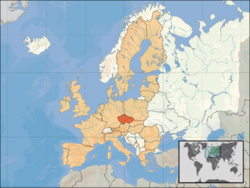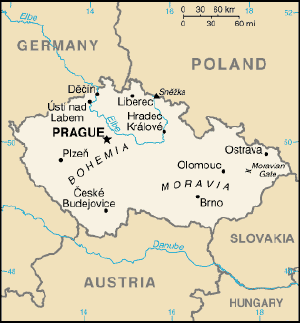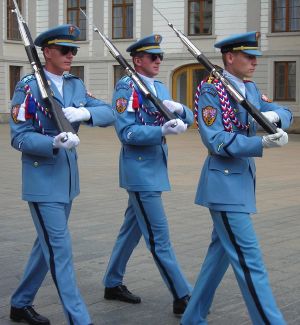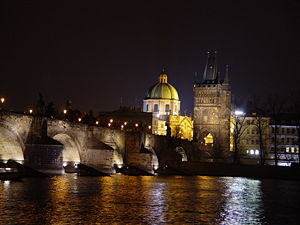Czech Republic
| Česká republika Czech Republic | |||||
| |||||
| Motto: Pravda vítězí (Czech: "Truth prevails") | |||||
| Anthem: Kde domov můj | |||||
|
Map showing the location of the Czech Republic (dark orange) within the EU (legend). | |||||
| Capital (and largest city) |
Prague 50°05′N 14°28′E | ||||
| Official languages | Czech | ||||
|---|---|---|---|---|---|
| Government | Republic | ||||
| - President | Václav Klaus | ||||
| - Prime Minister | Mirek Topolánek | ||||
| Formation | Ninth century | ||||
| - Independence from Austria-Hungary |
October 28, 1918 | ||||
| - Dissolution of Czechoslovakia | January 1, 1993 | ||||
| Accession to EU | May 1, 2004 | ||||
| Area | |||||
| - Total | 78,866 km² (117th) 30,450 sq mi | ||||
| - Water (%) | 2.0 | ||||
| Population | |||||
| - 2006 (30 Sept.) estimate | 10,280,968 | ||||
| - 2001 census | 10,230,060 | ||||
| - Density | 130/km² 337/sq mi | ||||
| GDP (PPP) | 2006 estimate | ||||
| - Total | $204.4 billion | ||||
| - Per capita | $20,000 | ||||
| GDP (nominal) | 2006 estimate | ||||
| - Total | $128,556 billion | ||||
| - Per capita | $12,504 | ||||
| HDI (2004) | |||||
| Currency | Czech koruna (CZK)
| ||||
| Time zone | CET (UTC+1) | ||||
| - Summer (DST) | CEST (UTC+2) | ||||
| Internet TLD | .cz 3 | ||||
| Calling code | +4201 | ||||
| 1 Shared code 42 with Slovakia until 1997 2 Rank based on 2006 IMF data 3 also .eu, shared with other European Union member states. | |||||
The Czech Republic (officially short form in Czech: Česko IPA: [ʧεsko]) is a landlocked country in Central Europe and a member state of the European Union. The country has borders with Poland to the north, Germany to the northwest and west, Austria to the south, and Slovakia to the east. The capital and largest city is the historic Prague (Czech: Praha), a major tourist attraction. Other major cities include Brno, Ostrava, Zlín, Plzeň, Pardubice, Hradec Králové, České Budějovice, Liberec, Olomouc, Karlovy Vary and Ústí nad Labem.
The country is composed of two entire historic regions, Bohemia and Moravia, and parts of Silesia.
Name
After the dissolution of Czechoslovakia, the Czech part found itself without a common single-word name. In 1993, The Czech Ministry of Foreign Affairs suggested the name Czechia as an official alternative in all situations other than formal official documents and the full names of government institutions, but this has not caught on in English usage. The official website of the Czech Republic (www.czech.cz) run by the Czech Ministry of Foreign Affairs does not use the name Czechia any longer as of 2006. Its Czech equivalent is Česko.
History
Archaeologists have found evidence of prehistoric human settlement in the area dating back to the Neolithic era. In the classical era, from the 3rd century B.C.E. Celtic migrations, the Boii (see Bohemia) and later in the 1st century Germanic tribes of Marcomanni and Quadi settled there. During the Migration Period of ca. the 5th century, many Germanic tribes moved westward and southward out of Central Europe. In an equally significant migration, Slavic people from the Black Sea and Carpathian regions settled in the area (a movement that was also stimulated by the onslaught of peoples from Siberia and Eastern Europe: Huns, Avars, Bulgars and Magyars). Following in the Germans' wake, they moved southward into Bohemia, Moravia, and some of present day Austria. During the 7th century the Frankish merchant Samo, supporting the Slavs fighting their Avar rulers, became the ruler of the first known Slav state in Central Europe. The Moravian principality arose in the 8th century (see Great Moravia).
The Bohemian or Czech state emerged in the late 9th century when it was unified by the Přemyslids. The kingdom of Bohemia was a significant local power during the Middle Ages. It was part of the Holy Roman Empire during the entire existence of this confederation.
Religious conflicts such as the 15th century Hussite Wars and the 17th century Thirty Years' War had a devastating effect on the local population. From the sixteenth century, Bohemia came increasingly under Habsburg control as the Habsburgs became first the elected and then hereditary rulers of Bohemia. After the fall of the Holy Roman Empire, Bohemia became part of Austrian Empire and later of Austria-Hungary.
Following the collapse of the Austro-Hungarian empire after World War I, the independent republic of Czechoslovakia was created in 1918. This new country incorporated regions with majority German, Hungarian, Polish and Ruthenian speaking populations. Although Czechoslovakia was a centralist state, it provided what was at the time rather extensive rights to its minorities. However, it did not grant its minorities any territorial political autonomy, which resulted in discontent and strong support among some of the minorities to break away from Czechoslovakia. Adolf Hitler used the opportunity and, supported by Konrad Henlein's Sudeten German Party, gained the almost wholly German speaking Sudetenland through the Munich Agreement. Poland occupied areas with Polish minority around Český Těšín, while Slovakia gained greater autonomy, with the state being renamed to "Czecho-Slovakia". Eventually Slovakia broke away further in March 1939, allied to Hitler´s coalition and the remaining Czech territory was occupied by Hitler who installed the so-called Protectorate of Bohemia and Moravia, which was proclaimed part of the Reich and where the Protectorate President and Prime Minister were subordinate to the Nazi Reichsprotektor ('imperial protector'). Approximately 390,000 citizens, including 83,000 Jews, were killed or executed, and hundreds of thousand of others were sent to prisons and concentration camps or forced labour. The Czechoslovak government-in-exile and its army fighting against the Germans were acknowledged by Allies (Czech troops fought in Great Britain, North Africa, Middle East and Soviet Union). Prague uprising ended the war.
In 1945-6 almost the entire German minority of Czechoslovakia, about 2.7 million people, were expelled to Germany and Austria. During this time, thousands of Germans were held in prisons, detention camps, and used in forced labour. In the summer of 1945, there were several massacres. Only 250,000 Germans who had been active in the resistance against the Nazis or were necessary for the economy were allowed to stay, though many of them emigrated later.
Czechoslovakia uneasily tried to play the role of a "bridge" between the West and East. However, the Communist Party of Czechoslovakia rapidly increased in popularity, particularly because of a general disappointment with the West (due to the pre-war Munich Agreement) and a favourable popular attitude towards the Soviet Union (due to the Soviets' role in liberating Czechoslovakia from German rule). In the 1946 elections, the Communists received a plurality of the vote (38%) and became the largest party in the Czechoslovak parliament. They formed a coalition government with other parties of the National Front, and moved quickly to consolidate power. The decisive step took place in February 1948. During a series of events characterized by communists as a "revolution" and by anti-communists as a "takeover", the communist People's Militias secured control of key locations in Prague, and a new, all-communist government was formed.
For the next 41 years, Czechoslovakia was a Communist state within the eastern bloc. This period was marked by a variety of social developments. The Communist government nationalized the means of production and established a command economy. The economy grew rapidly during the 1950s and 60s, but slowed down in the 1970s and stagnated during the 80s. Meanwhile, the political climate was highly repressive during the 1950s (including numerous show trials), but became more open and tolerant in the 1960s, culminating in the Prague Spring. This was forcibly ended on 21 August 1968 when an invasion by Warsaw Pact troops ended the efforts of the country's leaders to introduce political pluralism and create "socialism with a human face". From then until 1989, the political establishment returned to censorship of opposition, but without the highly repressive measures of the 1950s.
In November 1989, Czechoslovakia returned to a multi-party political system through a peaceful "Velvet Revolution". However, Slovak national aspirations strengthened until on January 1, 1993, the country peacefully split into the independent Czech and Slovak republics. Both countries went through economic reforms and privatizations, with the intention of creating a market economy.
From 1991 the Czech Republic, then Czechoslovakia, has been a member of the Visegrad Group and from 1995 of OECD. The Czech Republic joined NATO on March 12, 1999 and the European Union on May 1, 2004.
Geography
The Czech landscape is quite varied; Bohemia to the west consists of a basin, drained by the Labe (German: Elbe) and Vltava rivers, surrounded by mostly low mountains such as the Sudetes with its part Krkonoše, where one also finds the highest point in the country, the Sněžka at 1,602 metres (5,256 ft). Moravia, the eastern part, is also quite hilly and is drained predominantly by the Morava river, but also contains the source of the Odra (German: Oder) river. Water from the landlocked Czech Republic flows to three different seas: the North Sea, Baltic Sea and Black Sea. The Czech Republic also possesses a 30,000 square metre exclave in the middle of Hamburg docks which was awarded to Czechoslovakia by Article 363 of the Treaty of Versailles to allow the landlocked country a place where goods transported down river could be transferred to seagoing ships; this territory reverts to Germany in 2018.
Demographics
Population
| Population of Czech Lands (Czech Statistic. Ofice) | |||||
|---|---|---|---|---|---|
| Year | Total | Change | Year | Total | Change |
| 1857 | 7,016,531 | - | 1930 | 10,674,386 | 6.6% |
| 1869 | 7,617,230 | 8.6% | 1950 | 8,896,133 | -16.7% |
| 1880 | 8,222,013 | 7.9% | 1961 | 9,571,531 | 7.6% |
| 1890 | 8,665,421 | 5.4% | 1970 | 9,807,697 | 2.5% |
| 1900 | 9,372,214 | 8.2% | 1980 | 10,291,927 | 4.9% |
| 1910 | 10,078,637 | 7.5% | 1991 | 10,302,215 | 0.1% |
| 1921 | 10,009,587 | -0.7% | 2001 | 10,230,060 | -0.7% |
The vast majority of the inhabitants of the Czech Republic are Czechs (94.2%, out of which 3.7% claimed Moravian ethnicity and 0.1% Silesian in the 2001 census). Largest minorities are Slovaks (1.9%), Poles (0.5%), Germans (0.4%), and Roma people.
Religion
The Czech Republic, along with Estonia, has one of the least religious populations in the European Union. According to the 2001 census, 59% of the country is agnostic, atheist, non-believer or no-organized believer, 26.8% Roman Catholic and 2.5% Protestant.[1] According to a 2005 Eurobarometer poll, 30% of Czech respondents do not believe in a god, spirit, or life forces. 50% believe in some sort of spirit or life force, and 19% believe in a god.[2]
Weather and Climate
Czech republic has a temperate, continental climate with relatively hot summers and cold, cloudy winters, usually with snow. Most rains are during the summer. The temperature difference between summers and winters is relatively high due to the geographical position - no access to sea.
Even within the Czech republic, temperatures vary a lot depending on the altitude. In general, at higher altitudes the temperatures decrease and precipitation increases. Another important factor is the distribution of the mountains. The climate therefore is very diverse.
The annual average temperatures differ a lot with the altitude. At the highest peak (Snezka - 1602m) the average temperature is only -0.4°C, whereas in the lowlands of South Moravia, the average temperature is as high as 10°C and this also applies for the country capital Prague, but this is due to urban factors.
The coldest month is usually January followed by February and December. During these months there is usually snow in the mountains and sometimes also in the major cities and lowlands, but this snow tends to melt very quickly and so most of the winter is just wet.
During March, April and May, the temperatures usually increase rapidly and especially during April the temperatures and weather tend to vary a lot during the day. Spring is also characterized by high water levels in the rivers due to the snow melting and there are often floods.
The warmest month of the year is July, followed by August and June. On average, the summer temperatures are about 20°C higher than during winter. Especially in the last decade, temperatures above 30°C are not unusual. Summer is also characterized by rains and storms.
Autumn usually begins in September, which is still relatively warm, but much drier. During October, temperatures usually fall back under 15 or 10°C and decidious trees begin to drop off leaves. By the end of November, temperatures usually range around the freezing point.
Politics
Political system
Czech Republic is a pluriform multi-party parliamentary representative democratic republic, where the Prime Minister is the head of government. The Parliament is bi-cameral, with the Chamber of Deputies (Poslanecká sněmovna) and the Senate.
Military
The Czech Armed Forces (Czech: Armáda České republiky) consists of Land and Air Forces and of specialized support units. In 2004 the Czech military completely phased out conscription and transformed into a fully professional military force. The country has been a member of NATO since March 12, 1999. Military spending is around 1.8% of GDP (2006)
Administrative divisions
The Czech Republic is divided into 13 regions (kraje, singular - kraj) with their own assemblies and the capital city (hlavní město) Prague (Praha). The older 73 districts (okresy, sing. okres); 3 statutory cities with the status of districts (Statutární města, sing. Statutární město, viz. Brno, Ostrava and Plzeň); and the city-district-region of Prague (Hlavní město Praha) were disbanded in an ill-executed administrative reform[1]; however are still traditionally recognized and remain the seats of various branches of state administration[2].
| (Lic. plate) | Region | Capital | Population (2004 est.) |
|---|---|---|---|
| A | Prague (Praha) | — | 1,170,571 |
| S | Central Bohemian Region (Středočeský kraj) | offices located in Prague (Praha) | 1,144,071 |
| C | South Bohemian Region (Jihočeský kraj) | České Budějovice | 625,712 |
| P | Plzeň Region (Plzeňský kraj) | Plzeň | 549,618 |
| K | Karlovy Vary Region (Karlovarský kraj) | Karlovy Vary | 304,588 |
| U | Ústí nad Labem Region (Ústecký kraj) | Ústí nad Labem | 822,133 |
| L | Liberec Region (Liberecký kraj) | Liberec | 427,563 |
| H | Hradec Králové Region (Královéhradecký kraj) | Hradec Králové | 547,296 |
| E | Pardubice Region (Pardubický kraj) | Pardubice | 505,285 |
| M | Olomouc Region (Olomoucký kraj) | Olomouc | 635,126 |
| T | Moravian-Silesian Region (Moravskoslezský kraj) | Ostrava | 1,257,554 |
| B | South Moravian Region (Jihomoravský kraj) | Brno | 1,123,201 |
| Z | Zlín Region (Zlínský kraj) | Zlín | 590,706 |
| J | Vysočina Region (Vysočina) | Jihlava | 517,153 |
Economy
General situation
One of the most stable and prosperous of the post-Communist states, the Czech Republic has been recovering from recession since mid-1999. Growth in 2000-2001 was led by exports to the European Union, especially Germany, and foreign investment, while domestic demand is reviving. The rate of corruption remains one of the highest among OECD countries.
Uncomfortably high fiscal deficit is becoming a problem.
Moves to complete banking, telecommunications, and energy privatization will add to foreign investment, while intensified restructuring among large enterprises and banks and improvements in the financial sector should strengthen output growth.
The country is scheduled to fully implement the Schengen Agreement and therefore abolish the border controls with all of its neighbors (Germany, Austria, Poland, Slovakia) as of 31 December 2007.
The Czech government has expressed a desire to adopt the euro currency in 2010, but its introduction is only in the early planning stages and there are growing doubts whether budget deficit will not force postponement. More likely dates are 2011 or 2012.
Tourism
The Czech economy gets a substantial income from tourism: in 2001, the total earnings from tourism reached 118.13 billion CZK, making up 5.5% of GNP and 9.3% of overall export earnings. The industry employs more than 110,000 people - over 1% of the population.[3]
There are several centres of tourist activity: The historic city of Prague is the primary tourist attraction, and the city is also the most common point of entry for tourists visiting other parts of the country.[4] Most other cities in the country attract significant numbers of tourists, but the spa towns such as Karlovy Vary and Mariánské Lázně are particularly popular holiday destinations. Other popular tourist sites are the many castles and chateaux, such as those at Karlštejn, Konopiště and Český Krumlov. Away from the towns, areas as Český Ráj, Šumava and the Krkonoše mountains attract visitors seeking outdoor pursuits.
Culture
- Cinema of the Czech Republic
- List of famous Czechs
- Czech literature
- Music of the Czech Republic
- List of Czech musical groups
- National Theatre (Prague)
- List of Czech language television channels
- Czech cuisine
The country is also famous for its love of puppetry and marionettes. The Pilsner style beer originated in Western Bohemian Plzeň.
International rankings
- Human Development Index 2006: Rank 30st out of 177 countries
- Index of Economic Freedom 2006: Rank 21st out of 57 countries
- Reporters Without Borders world-wide press freedom index 2006: Rank 5th out of 168 countries
- Global Competitiveness Report 2006: Rank 29th out of 125 countries
- It was also ranked as the highest alcohol-consuming nation by The Economist in 2006.
Miscellaneous topics
- Communications in the Czech Republic
- Foreign relations of the Czech Republic
- Junák
- List of cities in the Czech Republic
- List of postal codes in the Czech Republic
- List of Czech Republic-related topics
- Public holidays in the Czech Republic
- Transportation in the Czech Republic
- Spa towns in the Czech Republic
Reference
- ↑ Obyvatelstvo hlásící se k jednotlivým církvím a náboženským společnostem (in Czech). Czech Statistical Office. Retrieved 2006-12-19.
- ↑ Social values, Science and Technology (in English) (PDF). Eurobarometer (June 2005). Retrieved 2006-12-19.
- ↑ Promotion Strategy of the Czech Republic in 2004 - 2010. Czech Tourism. Retrieved 2006-12-19.
- ↑ CZECH SIGHTS. Discover Czech. Retrieved 2006-12-19.
- Some of the material comes from the CIA World Factbook 2000 and the 2003 U.S. Department of State website.
External links
Government
- Czech Republic - Official Website
- Czech Press Agency news
- Government website
- Portal of the Public Administration of Czech Republic
- Senate website
- Presidential website, click for a pop-up overview of English-language content
News
- Czech Happenings - Czech News (formerly Czech Happenings, the oldest English language news about the Czech republic
- Prague Daily Monitor - Czech news
- The Prague Post - the Czech Republic's English-language newspaper
- The Prague Tribune - the Czech Republic's English-language magazine
- http://radio.cz/en/ - Website of the English service of Radio Prague
Wikitravel
- Czech Republic at Wikitravel - share your tourist experience
Albania · Andorra · Armenia2 · Austria · Azerbaijan1 · Belarus · Belgium · Bosnia and Herzegovina · Bulgaria · Croatia · Cyprus2 · Czech Republic · Denmark3 · Estonia · Finland · France3 · Georgia1 · Germany · Greece · Hungary · Iceland · Ireland · Italy · Kazakhstan1 · Latvia · Liechtenstein · Lithuania · Luxembourg · Republic of Macedonia · Malta · Moldova · Monaco · Montenegro · Netherlands3 · Norway3 · Poland · Portugal · Romania · Russia1 · San Marino · Serbia · Slovakia · Slovenia · Spain3 · Sweden · Switzerland · Turkey1 · Ukraine · United Kingdom3 · Vatican City
1 Has majority of its territory in Asia. 2 Entirely in Asia but having socio-political connections with Europe. 3 Has dependencies or similar territories outside Europe.
Credits
New World Encyclopedia writers and editors rewrote and completed the Wikipedia article in accordance with New World Encyclopedia standards. This article abides by terms of the Creative Commons CC-by-sa 3.0 License (CC-by-sa), which may be used and disseminated with proper attribution. Credit is due under the terms of this license that can reference both the New World Encyclopedia contributors and the selfless volunteer contributors of the Wikimedia Foundation. To cite this article click here for a list of acceptable citing formats.The history of earlier contributions by wikipedians is accessible to researchers here:
The history of this article since it was imported to New World Encyclopedia:
Note: Some restrictions may apply to use of individual images which are separately licensed.







